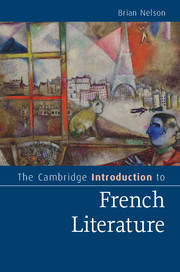Book contents
- Frontmatter
- Dedication
- Contents
- Preface
- Acknowledgements
- Chronology
- 1 Villon: a dying man
- 2 Rabelais: the uses of laughter
- 3 Montaigne: self-portrait
- 4 Corneille: heroes and kings
- 5 Racine: in the labyrinth
- 6 Molière: new forms of comedy
- 7 La Fontaine: the power of fables/fables of power
- 8 Madame de Lafayette: the birth of the modern novel
- 9 Voltaire: the case for tolerance
- 10 Rousseau: man of feeling
- 11 Diderot: the enlightened sceptic
- 12 Laclos: dangerous liaisons
- 13 Stendhal: the pursuit of happiness
- 14 Balzac: ‘All is true’
- 15 Hugo: the divine stenographer
- 16 Baudelaire: the streets of Paris
- 17 Flaubert: the narrator vanishes
- 18 Zola: the poetry of the real
- 19 Huysmans: against nature
- 20 Mallarmé: the magic of words
- 21 Rimbaud: somebody else
- 22 Proust: the self, time and art
- 23 Jarry: the art of provocation
- 24 Apollinaire: impresario of the new
- 25 Breton … Company: Surrealism
- 26 Céline: night journey
- 27 Sartre: writing in the world
- 28 Camus: a moral voice
- 29 Beckett: filling the silence
- 30 French literature into the twenty-first century
- Notes
- Further reading
- Index of authors and titles
- Index of genres, movements and concepts
- Cambridge Introductions to …
- References
13 - Stendhal: the pursuit of happiness
Published online by Cambridge University Press: 05 July 2015
- Frontmatter
- Dedication
- Contents
- Preface
- Acknowledgements
- Chronology
- 1 Villon: a dying man
- 2 Rabelais: the uses of laughter
- 3 Montaigne: self-portrait
- 4 Corneille: heroes and kings
- 5 Racine: in the labyrinth
- 6 Molière: new forms of comedy
- 7 La Fontaine: the power of fables/fables of power
- 8 Madame de Lafayette: the birth of the modern novel
- 9 Voltaire: the case for tolerance
- 10 Rousseau: man of feeling
- 11 Diderot: the enlightened sceptic
- 12 Laclos: dangerous liaisons
- 13 Stendhal: the pursuit of happiness
- 14 Balzac: ‘All is true’
- 15 Hugo: the divine stenographer
- 16 Baudelaire: the streets of Paris
- 17 Flaubert: the narrator vanishes
- 18 Zola: the poetry of the real
- 19 Huysmans: against nature
- 20 Mallarmé: the magic of words
- 21 Rimbaud: somebody else
- 22 Proust: the self, time and art
- 23 Jarry: the art of provocation
- 24 Apollinaire: impresario of the new
- 25 Breton … Company: Surrealism
- 26 Céline: night journey
- 27 Sartre: writing in the world
- 28 Camus: a moral voice
- 29 Beckett: filling the silence
- 30 French literature into the twenty-first century
- Notes
- Further reading
- Index of authors and titles
- Index of genres, movements and concepts
- Cambridge Introductions to …
- References
Summary
Beauty is nothing other than the promise of happiness.
– Stendhal, On LoveA child of the Enlightenment, a sympathizer with the Romantic movement and, with Honoré de Balzac, the progenitor of the realist novel, Stendhal (the pen name of Marie-Henri Beyle, 1783–1842) was one of the most original writers of his time. The themes and style of his major fictional works – The Red and the Black (Le Rouge et le noir, 1830), Lucien Leuwen (written 1834–35, published posthumously) and The Charterhouse of Parma (La Chartreuse de Parme, 1839) – have an almost self-contradictory quality: ironic and poetic, comic and tragic, satirical and lyrical. This is reflected in the psychological complexity of the central characters and the subtlety of Stendhal's style of narration. A particular blend of Romantic fervour and eighteenth-century rationalism gives his novels their distinctive quality. The characterization, themes and oblique narrative methods of Stendhal's fiction reflect his preoccupation with the nature of post-Napoleonic France and the problems of selfhood confronting the generation that grew up in the aftermath of Napoleon's downfall at the Battle of Waterloo in 1815.
After Waterloo
An ardent admirer of Napoleon, Stendhal thrived in the heady atmosphere of the Napoleonic age. In 1800 he joined Napoleon's army in Italy (but resigned his commission the following year). From 1806 to 1814 he served as an aide de-camp during the Emperor's campaigns in Germany, Austria and Russia. After the fall of Napoleon, he experienced French society – that of the Bourbon Restoration (1815–30) – as a dull anti-climax, presenting the spectacle of a philistine, money-grubbing bourgeoisie jostling for power with a stagnant, effete aristocracy. As the momentous events and military triumphs of the Napoleonic era receded into history, the world seemed to shrink and grow grey. The qualities Stendhal valued – energy, passion, spontaneity: the qualities he saw embodied in the Emperor – were those he found lacking in the world around him.
- Type
- Chapter
- Information
- The Cambridge Introduction to French Literature , pp. 90 - 95Publisher: Cambridge University PressPrint publication year: 2015



